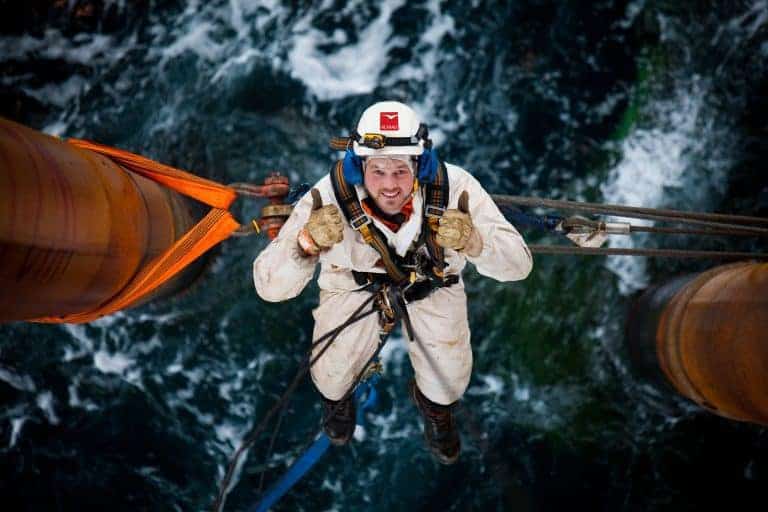Godiva becomes first scaffolding contractor to join The 5% Club
Coventry-based Godiva Access & Scaffolding has become the first specialist scaffolding contractor to join the 5% Club, an industry-led initiative focussed on driving momentum into the recruitment of apprentices, graduates and sponsored students.
The 5% Club, initiated by Leo Quinn CEO of Balfour Beatty in 2013, is a movement of more than 280 employers providing ‘earn and learn’ opportunities to develop the skills and talents people need to become more employable and create meaningful careers.
Colin Taylor, managing director at Godiva Access & Scaffolding, said: “By joining The 5% Club Godiva is committing to raising the number of apprentices, and graduates on formal programmes to 5% of our total workforce within five years.
“A skilled workforce is our biggest asset and is a business critical component that means we can deliver the safest and highest standard of service for our customers. The move is a natural extension of our strategy to become the scaffolding contractor of choice in our chosen markets.”
Lady Cobham, Director General of The 5% Club said, “We’re delighted to welcome Godiva Access & Scaffolding into membership. The 5% Club provides a fantastic network of HR professionals, sharing and learning from each other. All our members share an ethos of creating a skilled workforce through ‘earn and learn’ development programmes, helping people develop meaningful career paths.”
Godiva has recently started work as the access and scaffolding contractor for Winvic Construction on the new student accommodation complex in Fairfax Street, Coventry, and it has been appointed as the scaffolding framework contractor at the University of Warwick.
SGB provide access system for major Manchester development
An integrated access system from one of the UK’s leading scaffolding and access system providers has been used on a major new residential development in Manchester.
A total of 71 mastclimbers have been provided by SGB, for the creation of the Clipper’s Quay project which has been built by Sir Robert McAlpine in Salford Quays. The Clipper’s Quay project includes five blocks of between nine and 11 storeys, incorporating various commercial spaces and over 600 residential units, and it is believed to be one of the largest private rented sector developments outside London. “Scaffolding access was originally considered for this project, but a mastclimber solution proved to be much more cost-effective,” explains SGB’s Business Development Manager, Karl Hancock “We have worked with Sir Robert McAlpine on previous projects, so they were aware of our capabilities in servicing a large project such as this. They also knew that we could supply a range of different mastclimber solutions and associated equipment to suit the different requirements which a project such as this creates.” SGB worked closely with their client over an 18-month period, right from the design stage right through to delivery. “Being involved from a very early stage helps us to design an access solution which meets the client’s specific needs right from the outset, and which is also sufficiently flexible to accommodate any changes or unexpected requirements which arise over time,” adds Karl. “In this instance, we created a system which included a combination of single and twin mastclimbers, and this proved to be an extremely practical and cost-effective solution.”NASC appoints new in-house Marketing Manager
Record growth reported by Altrad
The Altrad group has reported strong growth in revenue and earnings from the Group’s expanded and diversified platform for the last fiscal half year.
Up to February 28th, they achieved record group revenue of €1,678 million with a full half-year contribution from Cape Altrad. A successful strategic focus on services contributed to 82 percent of turnover. Their Integration of the Cape business is progressing well and delivering expected synergies.Positive Figures
Impressive earnings before interest, taxes, depreciation and amortization (EBITDA) of €205million – a margin of 12 percent, offers a popular indicator of the company’s financial performance. The management expects to deliver a sustainably higher EBITDA margin going forward. Other highlights include a total backlog of €2,782 million providing good visibility on future revenue and diversification of geographic revenue with more than 30 percent coming out of Europe. Altrad has consolidated its position as a multi-disciplinary, industrial leader in key markets around the world, with a focus on Europe, Australia, Middle East, Africa and Asia.Securing Contracts
During the period, the Group was pleased to secure a number of material contracts, including an offshore maintenance contract in Angola awarded by BP for more than €30 million over three years and £25 million annual maintenance contracts, across the Grangemouth petrochemical facility in the UK. The strategic focus on Services provides strong visibility on future revenue, with more than 70 percent of the Group’s reported services revenue coming from recurring maintenance contracts.Setting Down A Marker
Commenting on the Results, CEO Louis Huetz said: “These results showcase the strength and breadth of our expanded business, highlighting the considerable progress we have made along our strategic growth path in the last few years. Our business is underpinned by strong cash flow and profitability, and our strategic focus on Services now provides good visibility on future revenue, with a secured order book of nearly €3 billion for delivery over the next few years.” The completion of the Cape acquisition has enabled the creation of a stronger and more balanced business, capable of delivering multi-disciplinary services to industry leaders throughout our chosen markets. The organic growth opportunities for the business remain compelling as we leverage our industry-leading platform to achieve better synergies, and demonstrate to our client base the benefits of our greater geographic footprint and diversified services.”
Catalyst For Success
In effect, the acquisition of Cape represents a truly transformative catalyst for the Altrad Group and continues the strategic development achieved by the acquisitions of Prezioso Linjebygg and Hertel in previous years. This delivery of record revenue and earnings surpasses internal budgets and supports the Group’s Full Year expectations. Such an outstanding performance was achieved within the first six-month contribution of the Cape business. The near-term outlook for the Group is positive, underpinned by improving market conditions in core sectors and geographies. Their strong order book comprises of diverse, recurring maintenance services contracts. Altrad’s business is now underpinned by diverse and steady revenue streams, from an international footprint and a balanced sales mix between its core sectors: Construction, Oil & Gas, Process Industries and Power Generation. During the period, the construction market has seen a recovery in activity, especially in continental Europe. As a result, the equipment business has seen an improved like-for-like performance, and the Group won a number of key services contracts including in France, where the Group was selected for the renovation of the Austerlitz railway station. This award follows the successful work delivered on Bordeaux Railway station last year, leaving Altrad well placed to benefit from the broader renovation program of the main French railway stations. Other key contract awards included the Acetylene project for BASF, a greenfield development of a new plant and the second largest project for German chemicals industry over the last decade.Looking Forward
Altrad’s strategic objectives remain to build a worldwide leader in industrial services, with market leading positions in key geographies and a diverse range of services.ScaffMag Issue 2 goes live
Our Spring 2018 Digital Issue has been published.
Following on from our successful launch issue back in the winter of 2017 – that was seen by more than 11,000 industry personnel, we now have the pleasure of letting you know our free Spring issue is now available to read and download now.
Click Here To Read Now
What’s inside this issue?
Packed into this 52 paged exciting issue of ScaffMag’s digital magazine offering features an exclusive interview with Lyndon Scaffolding’s CEO Rob Lynch as the firm turns 50 years-old. Additionally, we find out how the legendary firm that is SGB are well and truly back in business after reverting back to their well-known brand. We also speak to the Starwars scaffolder Eddie Gallen as he tells us what it was like to build the scaffold for the Millennium Falcon in the box office hit film ‘The Last Jedi’.
We also speak to the Starwars scaffolder Eddie Gallen as he tells us what it was like to build the scaffold for the Millennium Falcon in the box office hit film ‘The Last Jedi’.
Click Here To Read Now
The Regulars
Returning to this issue is our regular sections covering the latest industry news roundup, in our Opinion section Robin James from the NASC contributes by giving his perspective on the collapse of Carillion. And we find out that change is coming with the aid of Virtual Reality in our Innovations section. Plus much more. Happy reading!Submit News / Advertise In The Next Issue
Got some interesting industry news you would like to be featured in our next issue? Or do you have a product or service you want to showcase to thousands of industry eyeballs? We have a variety of advertising spaces available in our next issue. Drop us an Email »Wood awarded five year contract with Lucite International
Industrial services provider Wood has been awarded a new five-year contract by Lucite International UK Ltd.
Wood will be providing industrial services at the Cassel site in Billingham, Teesside, UK. Onshore fabrication, steelwork, electrical and rigging support services will be deployed under the new contract, which is effective immediately and includes a two-year extension option. Cassel is the largest methyl methacrylate (MMA) facility in Lucite International’s portfolio. It has been manufacturing chemicals at Billingham since 1930 with an annual capacity of 250 kilo-tonnes per year (kte). Dave Stewart, CEO of Wood’s Asset Solutions business in Europe, Africa, Asia & Australia, said: “This long-term contract builds on our relationship with Lucite International, developed following our recent work to support the refurbishment of the Cassel site. “We look forward to leveraging our broad industrial service capabilities to successfully deliver this contract, which further strengthens Wood’s onshore footprint within the chemical and manufacturing sector in the UK.”Tower crane drops pallet of bricks on pedestrian
A woman is fighting for her life after being hit by a pallet of bricks dropped from a tower crane.
The 28-year-old victim was passing a Higgins Homes construction site in east London yesterday morning when the crane dropped its load. According to reports, the Police in Tower Hamlets are appealing for witnesses after launching an investigation with the Health and Safety Executive. A police statement said: “Officers were called at 09:38hrs on Tuesday, 27 March to Burdett Road at the junction with St Pauls Way, E3. “A 28-year-old woman had apparently been struck by debris falling from a building site crane. “The London Ambulance Service attended and the woman was taken to an east London hospital, where she remains in a critical condition.”GKR develop new ‘Saddle’ scaffolding fitting
GKR Scaffolding is in the final weeks of testing and is soon to introduce a new multi-use fitting.
The new patent fitting called the “Saddle™” will be for the use with tube and fittings and system scaffolds. Group Director Lee Roswell at GKR Scaffolding broke the news on Linkedin late last week. Working in partnership with VR Access and Loughton Plant, Lee Roswell said: “The ‘Saddle™” has been developed as a multi-use fitting, having numerous applications for all scaffolding applications.” Uses with the Saddle™ fitting to include:- A replacement to the structural (Aberdeen) transom (final testings by end of March 2018)
- One piece tie to be used with drilled anchors
- Guardrail puncheons
- Loading bearing birdcages
- Loading bearing scaffolds
- Gantry Scaffolds
- Loading Bays
- Temporary roofs
- Sheeted and debris netted scaffolds for flush outside finish.
- Guardrails without protruding bolts

 At first glance, the ‘Saddle™’ coupler looks like it’s taken inspiration from a band and plate fitting and the shape of a couple of singles. GKR have confirmed the new fitting has a 9.1 kN capacity equal to an EN74-1-B Double Coupler.
GKR Scaffolding is no stranger to creating new revolutionary scaffold fittings after the success of their Elimin8 tethered fitting back in 2014.
This new product has taken GKR 18 months from concept to the final weeks of testing.
More to follow..
At first glance, the ‘Saddle™’ coupler looks like it’s taken inspiration from a band and plate fitting and the shape of a couple of singles. GKR have confirmed the new fitting has a 9.1 kN capacity equal to an EN74-1-B Double Coupler.
GKR Scaffolding is no stranger to creating new revolutionary scaffold fittings after the success of their Elimin8 tethered fitting back in 2014.
This new product has taken GKR 18 months from concept to the final weeks of testing.
More to follow.. Scaffolding Manager jailed for fraud
A scaffolding company manager has been jailed for stealing money from his own firm to fund a chronic gambling addiction.
Daniel Bell, 45, received a sentence of two-and-a-half years at Basildon Crown Court after admitting stealing £326,000 between June 2015 and July 2016. Working in his role as commercial manager for Durston Scaffolding Ltd based at Laindon, Bell was caught following an attempt to destroy documentation covering financial discrepancies at the company. He had previously falsified invoices so he could divert the cash straight into his own bank account in order to carry on his addiction.Repercussions For The Company
The actions of the former betting shop manager resulted in the company being forced into voluntary liquidation, also causing great embarrassment to the reputation of its owner and director. Paul Durston discovered holes in the accounts after returning from holiday. He confronted Bell, from Alburgh in Norfolk with facts, recording the conversation. Bell, who is married with a 13-year-old son then admitted committing fraud. Mr.Durston who is rebuilding his life has since managed to set up a new company called Durston Scaffolding Ltd, based in Canvey but with offices in London Road, Westcliff.Long-Term Problem
The court was told Bell had been addicted to gambling since he was a teenager as his mother had been in a relationship with a bookmaker. His own attempt at managing his own bookmaking shop proved to be unsustainable.












